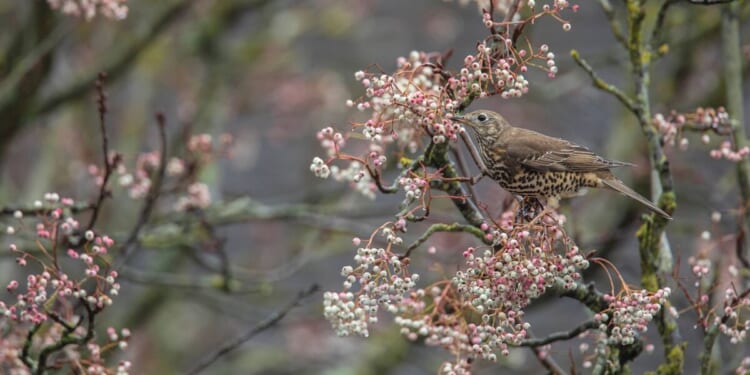Growing berry-producing shrubs and trees is said to be an almost foolproof method to attract birds to your garden as they prepare for winter. And if this is your goal, then you’ll be interested to know that certain berries appear to be favoured over others, with particular bird species showing preferences, according to Adrian Thomas, RSPB wildlife gardening expert.
He explains: “In particular, birds seem to prefer red berries, but that doesn’t mean that more unusual colours are to be avoided. Those which ripen to pink, white, or yellow may often be those that remain into the middle of winter when birds such as waxwings can be desperate for them. Of course there is even a British bird that is named because of its association with berries – the mistle thrush, which adores mistletoe.
“I wouldn’t be without lots of berry-bearing plants in the garden. To see flocks of birds descend on them in a feeding frenzy is always exciting, and if any of the feast lasts until winter, the chance of attracting redwings, fieldfares, or even the rare waxwing is a winter treat for us too.”
Join our WhatsApp community for the latest garden tips and tricks
Various berries mature at different periods, meaning that with some thoughtful planning you can offer a banquet spanning numerous months, beginning with Juneberry (Amelanchier lamarckii) and continuing until spring with ivy berries. Berry-producing shrubs can be planted in borders or containers, whilst some varieties can be trained along trellises, walls and fences.
Five berry-bearing climbers, shrubs and trees that Thomas considers essential in the garden
1. Ivy
The berries boast a high fat content and ripen sequentially over an extended period, lasting until spring. It’s crucial to allow ivy to reach the light for it to flower well and subsequently bear fruit.
Growing tips: Ivy is one of the simplest plants to cultivate – it isn’t particular about soil (though common ivy thrives better in alkaline soils) and can grow in both sun and shade, swiftly covering challenging areas such as dry spots and stabilising the soil. Just avoid placing it in an area that is constantly waterlogged.
2. Hawthorn
The red ‘haws’ are a staple in the countryside for all the common members of the thrush family – blackbird, song thrush, mistle thrush, redwing, and fieldfare. Peak consumption occurs from October to December. Their autumn flowers also provide late nectar for insects.
Growing tips: You can cultivate it as a specimen tree or a hedge in any garden soil in sun or partial shade. Steer clear of ground which is permanently waterlogged, which could rot the roots. If you’re creating a new hedge, plant bare root hedging plants between October and February.
3. Holly
Bear in mind that holly bushes are either male or female, and you’ll need a female variety to ensure winter berries. You may have to plant a male as well for pollination if there isn’t one nearby. The red berries are again staples for the thrush family, plus wood pigeons.
Growing tips: Hollies are quite adaptable, not being particular about their soil type or location. All hollies can handle shade, although variegated varieties thrive better in sunlight. If you’re short on space, opt for a self-fertilising one which doesn’t require a partner to yield berries, such as ‘J. C. Van Tol’.
4. Rowan
In addition to the native rowan, many other garden varieties and cultivars are fantastic for their berry production, including the pink-berried Sorbus vilmorinii. For the native rowan, peak consumption occurs in August, before the winter-visiting redwings and fieldfares arrive.
Growing tips: Once again, it’s not picky, flourishing in sun or partial shade, but aim to grow it in moderately fertile, humus-rich soil. Pruning isn’t necessary, although you can remove dead branches in winter. While some rowans like mountain ash can grow to around six metres, there are smaller ones available, such as the yellow-berried ‘Joseph Rock’, which makes an ideal specimen tree, reaching four metres in 10 years.
5. Bird cherry
A native tree of the northern half of the UK, the deep red berries of Prunus padus ripen to shiny black and are small enough for smaller birds such as blackcaps and robins to eat, as well as the thrushes.
Growing tips: Ideally, plant this deciduous tree in autumn in moderately fertile soil in full sun. It can grow to 15m tall and almost the same in width, so you’ll need a large garden, although more compact varieties such as Prunus padus ‘Albertii’ are available.

















